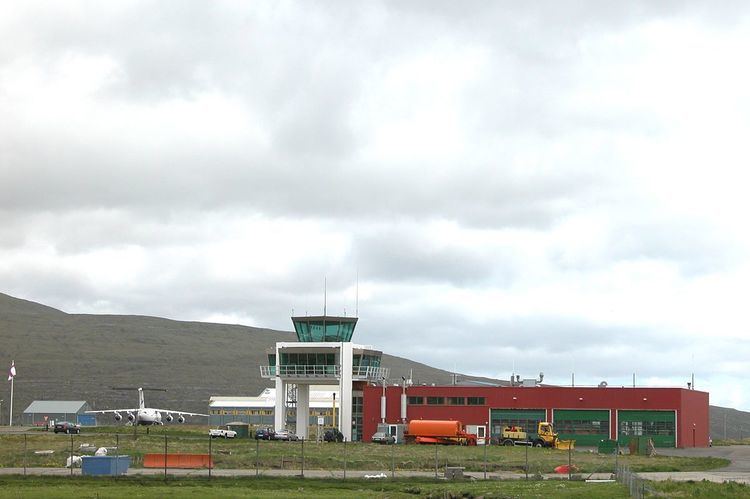Airport type Public Elevation AMSL 280 ft / 85 m Code FAE Phone +298 354400 | Website floghavn.fo Elevation 85 m | |
 | ||
Operator Civil Aviation Administration Similar 62°N Airport Hotel, Hotel Vagar, Hotel Føroyar, GreenGate Incoming, Hotel Streym | ||
Atlantic airways airbus a319 landing in v gar airport
Vágar Airport (Faroese: Vága Floghavn) (IATA: FAE, ICAO: EKVG) is the only airport in the Faroe Islands, and is located 1 NM (1.9 km; 1.2 mi) east of Sørvágur. Due to the Faroe Islands' status as a self-governing territory, the airport is not subject to the rules of the European Union. It is the main operating base for Faroese national airline Atlantic Airways and, for a brief period during 2006, was also the base for the low cost airline FaroeJet.
Contents
- Atlantic airways airbus a319 landing in v gar airport
- Early years
- Development since the 2000s
- Airlines and destinations
- Ground transport
- Accidents and incidents
- References
Early years
The airport was built by British Royal Engineers during World War II on the island of Vágar. The site was chosen mainly because it was hard to see from the surrounding waters and any potential German warship. The first aeroplane landed here in Autumn 1942. (See British occupation of the Faroe Islands in World War II).
After the war the airfield was abandoned and left unused until 1963 when it was reopened as a civilian airport at the initiative of two Sørvágur residents, Hugo Fjørðoy and Lars Larsen. The two worked with the Icelandic airline Icelandair, which began the scheduled flights to Bergen, Copenhagen and Glasgow using a Douglas DC-3 aircraft. In 1964 a separate airline, Faroe Airways, operated flights, first using chartered aircraft but in 1965 they bought a DC-3 from the Swedish airline Linjeflyg. The company ceased operating on 28 September 1967. In 1971, Icelandair was operating Boeing 727-100 jetliners into the airport with weekly nonstop service to Glasgow and Reykjavik. In 1988, Atlantic Airways was flying British Aerospace BAe 146-200 jet service nonstop to Copenhagen. Until 2004 Maersk Air also operated flights into the airport. Maersk Air flew Boeing 737-500 jetliners into the airport with service to Copenhagen.
Development since the 2000s
Until 2002 travel from the airport to most locations in the Faroe Islands including the capital Tórshavn required a car ferry, but since a tolled road tunnel was opened, travel has been made much easier by giving direct road access to the neighbouring island of Streymoy, where Tórshavn is located.
A new terminal opened 17 June 2014 with increased passenger capacity.
The runway was extended from 1,250 m (4,100 ft) to 1,799 m (5,902 ft) in 2011, allowing a greater variety of aircraft types to be used, and further-away destinations to be introduced. Construction work started in May 2010, and on 3 December 2011, the extended runway was opened and put into use for the first time. Previously, jet aircraft with short airfield performance such as the British Aerospace BAe 146 (which ceased to be produced 2001) were preferred for use into the airport (although Maersk Air operated flights with Boeing 737-500 aircraft), and then the most distant destination was Copenhagen, 1,300 km (810 mi). The Airbus A319 of Atlantic Airways is able to utilise the extended runway, and services with this type with Atlantic Airways began in March 2012. Tourist summer flights to Barcelona and Milan were introduced. However, in 2014 they decided to stop the routes to Milan and to London. Instead, they chose to fly to Mallorca and to Aberdeen, later changed to Edinburgh.
The airport is currently managed by the Danish Transport Authority although the ownership of the airport was handed over to the Faroese government in May 2007.
A number of domestic Faroese destinations can be reached from Vágar by the Atlantic Airways helicopter service. International destinations include Copenhagen, Aalborg and Billund in Denmark, Reykjavík in Iceland, Edinburgh in the United Kingdom (Scotland), Bergen in Norway and Barcelona and Palma de Mallorca in Spain.
Airlines and destinations
The following airlines offer regular passenger scheduled and charter flights at Vágar Airport:
There are occasional public charter flights done by major European airlines, e.g. Wizzair and Austrian Airlines, for example for supporters to football qualification matches. There are also fairly frequent corporate charter flights (seats not available to public) done by e.g. Widerøe. The extended runway and better instrument landing system has made it easier for other airlines than Atlantic Airways to land at Vagar.
Ground transport
There are bus services about 10 times each direction per day between the airport and Tórshavn. They take one hour. The road distance to Tórshavn is 47 km (29 mi). The "Vágatunnilin" tunnel (4.9 km (3.0 mi)) connects the airport and the Vágar island to the main towns and villages in the Faroe Islands.
